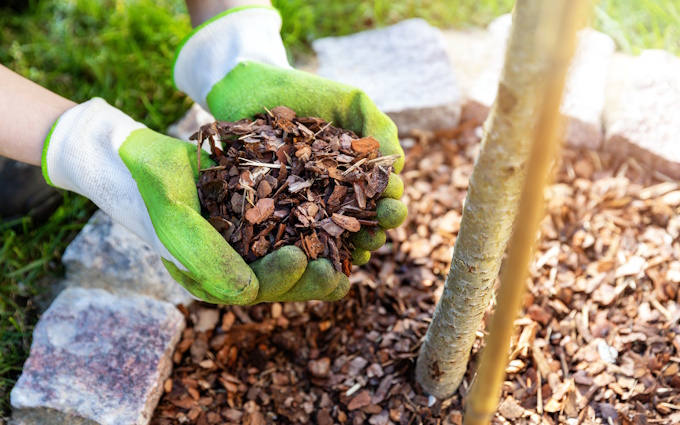The Eisenhower Team Delivers Full-Service Tree Care That Fosters Healthy Growth
By taking proactive steps to care for your trees in the spring, you set the stage for robust growth and vibrant health throughout the year, particularly after the winter season of dormancy.
In this guide, we’ll explore arborist-approved tips homeowners can use to support tree health. We’ll also discuss which tree scenarios warrant the attention of arborists and tree surgeons.
Perform a Post-Winter Yard Cleanup
Your yard is the canvas that complements your home and showcases your creativity and commitment to curb appeal. If you’re like most folks, you didn’t do much beautification during the winter, meaning the metaphorical canvas is littered with leaves, twigs, and other forms of debris.
Kick things off by giving your yard a thorough post-winter cleanup. This not only enhances the overall aesthetics but also removes potential breeding grounds for pests and diseases. Starting with a clean slate sets the foundation for successful spring tree care.
Perform a Thorough Tree Inspection
Most trees come out of dormancy starting in March. Before delivering any tree care services, it’s important to assess their current state. Some trees handle winter better than others. It’s also worth noting that if your trees entered dormancy with nutrient deficiency issues, structural problems, invasive pests, or fungi, those problems likely carried over into the new year.
Although you may not be a certified arborist, you can still perform the initial tree assessment. Keep an eye out for the following signs and symptoms that indicate your tree is in poor health:
- Dead branches and twigs
- Fungal growth
- Abnormal bark
- Cracks and wounds in the trunk
- Wilting
- Decay or rot
- Exposed or damaged roots
If you notice any of these signs, contact an arborist in Kansas City at Eisenhower Tree Care who can diagnose the issue and provide rehabilitation services. Early detection allows for timely intervention, safeguarding the health and longevity of your trees.
Remove Landscape Hazards
Tree rehabilitation services may not be enough in some cases. If your tree has significant rot or other structural issues, tree removal may be the best course of action. Although the idea of removal may seem extreme, homeowners must remember that diseased and pest-infested trees can compromise adjacent landscaping elements. They also pose a safety hazard to pedestrians and property.
For professional tree and stump removal services, contact the Eisenhower Tree Care team. We have equipment ready for stump grinding and large tree removal jobs, and no tree is too large for us. Our team is highly experienced, so you can expect efficient tree removal with minimal disruption to your surrounding landscape features and lawn.
As a leading provider of tree care services in the greater Kansas City area, our team follows arborist and tree surgeon-approved methods of removal and safety practices. You can learn more about tree removal safety, our process, and tree removal pricing when you call us at (816) 237-0705.
Apply a Fresh Layer of Mulch
Midwestern winters impact soil conditions, which makes it difficult for your trees to draw the moisture they need to bloom. Applying a fresh layer of mulch at the base of the tree can help retain moisture, regulate soil temperature, and suppress weed growth. Leave a gap around the trunk to prevent moisture buildup against the bark, reducing the risk of diseases and root rot.
Pruning for Health and Shape
Spring is an ideal time for pruning because it removes dead and diseased branches from the equation, ensuring healthy branches receive nutrients. Pruning also promotes air circulation and sunlight exposure to deeper parts of the tree’s canopy.
If you’re not skilled in the meticulous art of pruning, contact Eisenhower Tree Care to ensure the job gets done right. We adhere to pruning methods used by certified arborists and tree surgeons.
Apply Fertilizer Using Arborist Approved Methods
Fertilizing in the spring nourishes the soil, supporting robust foliage and vibrant blooms. The challenge is that trees aren’t universally fertilized the same way. Tree species, age, and soil conditions must be factored in.
Homeowners also must weigh the pros and cons of using chemical fertilizers versus organic fertilizers. Most arborists agree that organic options are the way to go because they promote better soil conditions and require fewer applications.
Keep Your Trees Properly Hydrated
Trees that have recently come out of dormancy need plenty of water to replenish and prepare for the hot summer months that lie ahead. Similar to tree fertilization, different trees have different watering needs.
A good rule of thumb to follow – especially with established trees – is to focus on watering depth rather than frequency. Ideally, the water trickles down to the required soil depth where the tree’s root system is located. Younger trees with shallow root systems will not need such deep watering.
Monitor and Maintain
Regularly monitor the condition of your trees throughout the spring. Watch for changes in leaf color, abnormal growth patterns, or other signs of distress. Adjust your care routine based on your observations and seasonal variations. The arborists at Eisenhower are available to diagnose and service your trees if you suspect there’s a problem.
Contact Eisenhower’s Team of Arborists For Spring Tree Care
By employing spring tree care tips and best practices, homeowners can contribute to the vitality and beauty of their trees. With a little care and attention, your trees will flourish, providing shade, beauty, and a thriving ecosystem for years to come.
Remember, it’s always best to address potential issues at the earliest stage possible. If you suspect your trees have a health or structural issue, contact an Eisenhower Tree Care. Our Kansas City arborists can address the spectrum of issues that threaten the health and vitality of your trees.
Call us at (816) 237-0705 or email us using our contact form to schedule an appointment. After assessing your trees, the Eisenhower team will develop an action plan designed to help you realize your spring tree care goals.

